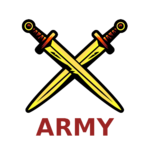Florian Army
| Florian Army | |
 | |
| Country |
|
|---|---|
| Founded | 1672 AN |
| Headquarters | Northcliff |
| Leadership | |
| Commander-in-Chief | Nick Borisov |
| Secretary of defence | Blake Pearce |
| Manpower | |
| Military age | 18-36 |
| Conscription | Yes |
| Expenditures | |
| Percent of GDP | 3.5% |
The Florian Army is the principal land warfare force of Floria, a part of the Confederate States Armed Forces along with the Florian Air Force and Florian Navy.
History
In the pre-1727 Florian Army, the Home Service Regiments, grouped under the Home Army, served as the parent formations for the majority of battalions assigned to operational divisions. This entailed maintaining a cadre that would provide administrative, disciplinary, pay, and training support to commissioned officers and non-commissioned officers alike in the raised battalions in the field. As such these Home Service Regiments could be considered more akin to the administrative corps and services branches of armies in other Raspur Pact armed forces.
Thus the Army Training Regiment at Arndale Camp (Longsight) would receive enlisted volunteers for their initial period of basic training, these recruits would then be assigned to a suitable Home Service Regiment for their specialism training. These regiments included:
- Army Infantry Regiment
- Army Armoured Regiment
- Army Artillery Regiment
- Army Air Defence Regiment
- Army Provosts Regiment
- Army Commissariat Regiment
- Army Signals Regiment
- Army Engineering Regiment
There was also the the General Service Regiment, which served as the parent regiment for "specialists" - considered something of a maddening formation by purists as it generally provided cadre support for personnel whose duties were not encompassed by any of the other Home Service Regiments.
It became customary over time for each of the Home Service Regiments to award a distinctively coloured and plumed beret, adorned with the regimental cap badge, to their trained cadres - something they would continue to wear with their service uniforms whilst assigned to operational units. The regimental colour and badge would over time become something of a source of allegiance for personnel whose careers could see them pass through a dizzying array of formations and postings.
There was also the Republican Guard Corps, which maintained its own separate identity, traditions, and training regime, and which should be addressed as a distinct entity in spite of being grouped under the Home Army.
The purpose of the Home Army, beyond the defence of the capital and the government, was to generate the substantial manpower required by the greater part of the Florian Army. This force consisted of seven field armies divided between Army Group East & Army Group West. Owing to the threat posed by the innumerable hordes of Jingdao, whose brief occupation of Floria during the War of Lost Brothers had been seared into the national psyche, the Florian Army had received the majority of the manpower allocation of the Confederate States Armed Forces upon the reestablishment of the Florian military. This million strong army, necessarily focused on formations at the army, corps, and division level, at the expense of the battalions. Thus a unit identity could expressed, for instance, in the form of being the 1st Infantry Battalion, 2nd Brigade of the 42nd Florian Assault Grenadier Division. This allowed for the rapid assignment of freshly trained cadres arrived from the Home Service Regiments, but did not lend itself to the development of especially strong unit identities.
Although it varied, from time to time, and from place to place, a field army would consist of two corps, which in turn consist of two divisions and a commissary (combat support and logistics) brigade.
A division would ideally consist of 14,400 men, formed of 2 brigades, with each brigade of six battalions expected to an artillery battalion, an air defence battalion, and a signals battalion attached. A brigade would also have either two infantry battalions and one armoured battalion if it belonged to a grenadier division, or two armoured battalions and an infantry battalion if the division had been designated as cavalry.
This system largely held until the defences reforms began in 1711 AN, which would see the army substantially reorganised over successive years.
Equipment
Current deployments
Structure
Recruitment
Uniforms
The Florian Army uniform has sixteen categories, ranging from ceremonial uniforms to combat dress to evening wear. No. 8 Dress, the day-to-day uniform, is known as PCS and consists of a Multi-Terrain Pattern (MTP) windproof smock, a lightweight jacket and trousers with ancillary items such as thermals and waterproofs.Insignia is denoted the wearer showing their regiment or corps. In addition to working dress, the armed forces has a number of parade uniforms for ceremonial and non-ceremonial occasions. The most-commonly-seen uniforms are No.1 Dress (full ceremonial, seen at formal occasions) and No.2 Dress (Service Dress), a brown khaki uniform worn for non-ceremonial parades such as Passing Out parades.
Working headdress is typically a beret, whose colour indicates its wearer's type of regiment. Beret colours are as follows:
Khaki—Presidents Foot Guards,
Light Grey— Confederate States Nursing Corps, The Greys Cavalry Regiment, Kingsland Regiment, Southland Regiment
Brown— Presidents Hussars
Black— Presidents Tank Regiment
Dark (rifle) green— Confederate States Rifles Regiment, The Presidents Dragoons
Maroon— The Confederate States Airborne Regiment
Beige— Special Warfare Service
Sky blue—Army Air Corps
Cypress green—Intelligence Corps
Scarlet— Provost Corps
Green— Adjutants General Corps
Navy blue— Other such as The President’s Own Cavalry, Light Dragoons